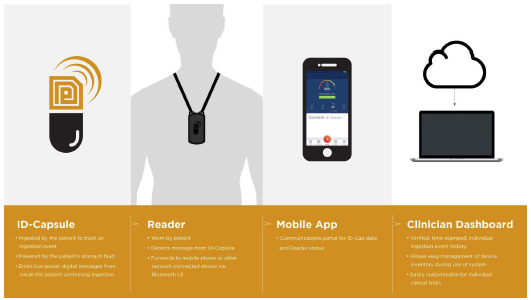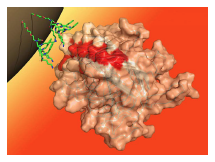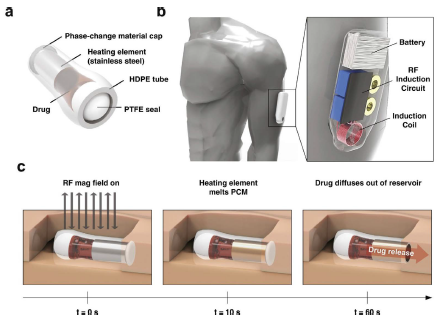Newly FDA-Approved Ingestible Pill Challenges Struggling Proteus
Trend Watch: From ingestibles to implants, medical devices continue to create healthcare solutions
 The FDA approved an ingestible event marker from the privately held digital health company etectRx. The Florida-based company said the ID-Cap system means this is the first device of its kind to transmit digital messages from within the body to an external receiver without need for direct skin contact. The system consists of the ID-Capsule, a standard pharmaceutical capsule containing the ingestible sensor known as the ID-Tag. This emits a very low-power digital message from within the patient after it is ingested and activated by the patient’s stomach fluid.
The FDA approved an ingestible event marker from the privately held digital health company etectRx. The Florida-based company said the ID-Cap system means this is the first device of its kind to transmit digital messages from within the body to an external receiver without need for direct skin contact. The system consists of the ID-Capsule, a standard pharmaceutical capsule containing the ingestible sensor known as the ID-Tag. This emits a very low-power digital message from within the patient after it is ingested and activated by the patient’s stomach fluid.
The ID-Cap Reader worn on a lanyard verifies the message is valid and forwards the data to a secure smartphone app and healthcare provider in a secure Web-based portal. etectRx says it is working with healthcare providers, health systems, pharmacies, pharma, and clinical research organizations to find applications for its technology. Researchers at Brigham and Women’s Hospital and Fenway Health are evaluating the ID-Cap system in ongoing and planned clinical studies focusing on HIV medication when used for treatment and prevention.
Proteus Digital Medicine developed the first such system, but uptake has been slow.
The news of a potential competitor comes at a bad time for Proteus, which has reportedly furloughed its employees for several weeks because of cash shortages.
Peptoid-Coated Magnetic Beads to Diagnose Prion Diseases, Alzheimer’s, Parkinson’s
 Researchers at Lawrence Berkeley National Laboratory have developed synthetic peptoide-coated magnetic beads that can be used to detect the presence of misfolded proteins in blood samples. Misfolded proteins are a factor in a number of diseases, including prion diseases, Alzheimer’s, and Parkinson’s. To date it has been difficult to detect such proteins in patient blood samples, often because they are present in very small quantities and closely resemble their correctly folded cousins. The new beads bind to specific misfolded proteins in blood samples, paving the way for rapid and convenient diagnosis of diseases that involve misfolded proteins.
Researchers at Lawrence Berkeley National Laboratory have developed synthetic peptoide-coated magnetic beads that can be used to detect the presence of misfolded proteins in blood samples. Misfolded proteins are a factor in a number of diseases, including prion diseases, Alzheimer’s, and Parkinson’s. To date it has been difficult to detect such proteins in patient blood samples, often because they are present in very small quantities and closely resemble their correctly folded cousins. The new beads bind to specific misfolded proteins in blood samples, paving the way for rapid and convenient diagnosis of diseases that involve misfolded proteins.
To date, there has been no convenient or minimally invasive way to test for proteins related to prion diseases. This poses a problem for diagnosis, but also in making sure that donated blood is free from prion contamination.
This group of researchers has developed a new way of testing for misfolded proteins in blood samples. Their technique involves synthetic peptides, called peptoids, that are attached to magnetic beads.
“Our peptoid beads have the ability to detect the misfolded proteins that act as infectious agents, so could have a significant impact in the realm of prion diseases, but we have also shown that they can seek out the large aggregated proteins that are the disease agents in Alzheimer’s and Parkinson’s diseases, among others," says Ronald Zuckermann, a researcher involved in the project. “Prion diseases are rare, but there are many misfolded protein-based diseases, which affect millions of people, that are also very poorly understood. And like prion diseases, we need a way to diagnose these slow-onset conditions in the years before symptoms arise."
By coating magnetic beads with peptoids that mimic the misfolded protein being detected, the beads bind to the protein when they are both present in a blood sample. This results in large protein aggregates. “It’s like Velcro; the aggregated misfolded protein has multiple hooks — multiple binding sites — that will attach to the bead, which is like the complementing sheet," says Michael Connolly, another researcher involved in the study. “But the natural, correctly folded protein only has a single hook, so its binding affinity is much less."
Once the misfolded proteins have bound to the beads, they can be removed from the blood sample using a magnet, and they can then be analyzed for the presence of the misfolded proteins using an assay. The process is quick and convenient and could revolutionize the diagnosis and detection of misfolded protein-based diseases.
Mayo Clinic Appoints First Chief Digital Officer
 Mayo Clinic has appointed Rita Khan to serve as the Rochester, Minn.-based health system’s chief digital officer, a newly created role in which she will lead the launch of a new center for digital health.
Mayo Clinic has appointed Rita Khan to serve as the Rochester, Minn.-based health system’s chief digital officer, a newly created role in which she will lead the launch of a new center for digital health.
Ms. Khan will guide Mayo Clinic’s digital strategy, including preparing the health system for digital transformation and implementing a business plan and system of standards that align with Mayo Clinic’s existing culture and values. This work will also include the establishment of the Mayo Clinic Center for Digital Health.
Before joining the health system, Ms. Khan served as senior VP of consumer digital at UnitedHealthcare. Before transitioning into the healthcare industry, she held product-focused roles at Digital River, Best Buy, Macy’s, and Target.
“I’m excited to align my deep background in retail, and most recently healthcare, to focus on consumer experience, product design, and digital with an organization whose values I share — grounded in always putting the consumer first," Ms. Khan said in a release. “Mayo Clinic was founded on the belief that the needs of the patient comes first. I look forward to helping advance that commitment as we expand our digital solutions for the people we serve."
IdaFlo Tr Monitors Blood Flow After PCI
The IdaFlo Tr wearable from IdaHealth monitors the flow through the radial artery to offer an early warning of complications after PCI procedures.
The radial artery can sometimes become blocked after transradial percutaneous coronary interventions. Worn on the wrist near the access site, the IdaFlo Tr from IdaHealth helps reduce the risk of such complications by monitoring the blood flow through the artery. If an abnormally slow flow is detected, the system will sound an alarm.
In tests, the IdaFlo Tr provided clinicians with the information needed to adjust compression and close the access site to prevent occlusions. “The advantages of IdaFlo Tr are remarkable," Dr. Giovanni Amoroso, an interventional cardiologist in Amsterdam, The Netherlands, said in a statement.
Wearable Device Delivers Naloxone During Opioid Overdose
 Purdue University researchers are developing a device that would automatically detect an overdose and deliver naloxone, a drug known to reverse deadly effects of opioid overdose.
Purdue University researchers are developing a device that would automatically detect an overdose and deliver naloxone, a drug known to reverse deadly effects of opioid overdose.
The team has built a wearable device designed to detect when a person’s respiration rate decreases to a certain level — converted from electrocardiography (EKG) signals — and then release naloxone, which blocks the opioid from binding to brain receptors.
Wearing the device would be similar to wearing an insulin pump: The current proof of concept is an armband that straps on a magnetic field generator, connected to a portable battery worn at the hip. A sticker-like EKG sensor on the skin, such as on the chest, measures respiration rate. When the sensor detects a respiration rate that’s too low, it activates the magnetic field generator to heat up a drug capsule in the body, releasing naloxone in 10 seconds.
The researchers envision the drug capsule being pre-injected under the skin in an outpatient setting. That way, the device system would automatically deliver naloxone to the patient during an overdose, buying about an hour before relapsing.
Although the device doesn’t yet work automatically, the researchers demonstrated through in vitro and in vivo experiments that the setup successfully detects a low respiration rate from EKG signals and delivers naloxone. Their work appears in the Journal of Controlled Release.
The device has been patented through the Purdue Research Foundation Office of Technology Commercialization. The researchers have since downsized the magnetic field generator and battery so that the device is less bulky.
The researchers also plan to build a communications system into the device that would automatically alert emergency services when the patient has overdosed. The technology could possibly deliver other drugs besides naloxone, such as epinephrine for people with allergies.
This work was supported by a grant from the National Institute on Drug Abuse and a fellowship by the National Science Foundation.(PV)


















